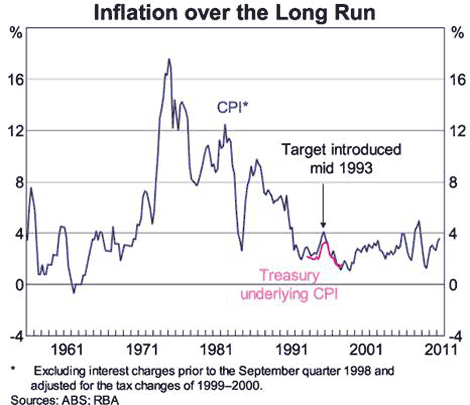Third-quarter inflation of 0.6% means rates could be cut on Cup Day
The much-anticipated headline inflation figure for the September quarter has met economists' expectations at 0.6%, but it is the underlying inflation figure of 0.3% whch has made the prospect of a Melbourne Cup Day rate cut more likely.
The September figure equates to 3.5% through the year to the September quarter 2011, compared with a rise of 3.6% through the year to the June quarter 2011.
Ben Jarman, economist at JP Morgan, says the inflation number is not enough to get the RBA over the line for a rate cut, though it gives the central bank scope to act if things worsen offshore.
But Shane Oliver at AMP Capital suggests the benign September quarter underlying inflation result is consistent with his expectations for a cut in interest rates.
"Today’s CPI figures came in on the low side of expectations which has opened the door for an RBA rate cut next week. The trimmed mean data showed an easing of inflation pressures which now gives the RBA room to move to the downside on Monetary Policy settings, now that they don’t need to be battling inflation like in days gone by," says Tim Waterer, senior FX Dealer at CMC Markets.
ANZ head of Australian economics Ivan Colhoun says the inflation figure suggests the RBA has room to reduce interest rates with the bank expecting to see a 25-basis-point cut in rates on Melbourne Cup day.
HIA senior economist Andrew Harvey says the inflation figure "leaves the RBA with plenty of space to cut rates by the end of this year".
Headline inflation rose 0.9% in the June quarter 2011 (3.6% for the year), compared with a rise of 1.6% in the March quarter 2011 (3.3% for the year.)
The most significant price rises this quarter were for electricity (+7.8%), international holiday travel and accommodation (+5.1%), rents (+1.2%), water and sewerage (+8.6%) and property rates and charges (+5.2%).
The most significant price falls this quarter were for pharmaceutical products (–5.0%), audio, visual and computing equipment (–3.3%), automotive fuel (–1.4%), vegetables (–2.5%), motor vehicles (–1.0%) and fruit (–1.2%).
A survey of 12 economists by AAP accurately forecast headline CPI to have risen by 0.6% in the September quarter and 3.5% in the 12 months to September.
The Commonwealth Bank also accurately forecast a 0.6% increase in headline CPI, with chief economist Michael Blythe noting that the September number had “extra significance” for the RBA in its decision about future interest cuts.
Blythe also highlighted that the “not-seasonally adjusted CPI will remain the official measure of inflation”.
The September quarter figure was the first to incorporate revised CPI weights and seasonal adjustment of a larger number of CPI components. Rental payments, household services, health services and education all received a greater weighting in CPI calculations.
Blythe says changes to the way CPI inflation is calculated will “probably work against a lower inflation trajectory. Better inflation outcomes will rely instead on weaker global and domestic growth actually coming through”.
NAB economists noted the RBA’s acknowledgement that “an improved inflation outlook ‘would increase the scope for monetary policy to provide some support to demand, should that prove necessary’".
Since 1993, the RBA has set monetary policy to achieve an inflation rate of 2% to 3%, on average over the economic cycle, “a rate of inflation sufficiently low that it does not materially distort economic decisions in the community”.

“The inflation target is also, necessarily, forward-looking. This approach allows a role for monetary policy in dampening the fluctuations in output over the course of the cycle. When aggregate demand in the economy is weak, for example, inflationary pressures are likely to be diminishing and monetary policy can be eased, which will give a short-term stimulus to economic activity,” the RBA explains.
The RBA has kept the cash rate at 4.75% since November 2010.
It will next make a decision about interest rates on Melbourne Cup Day, November 1.